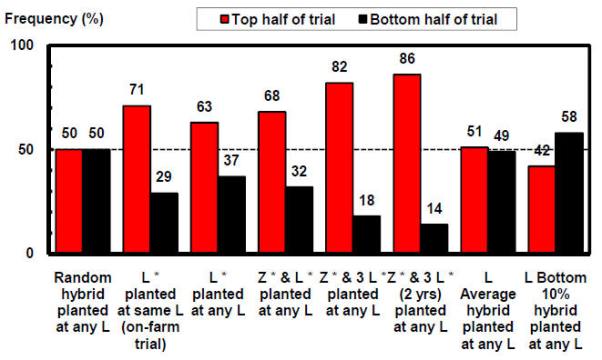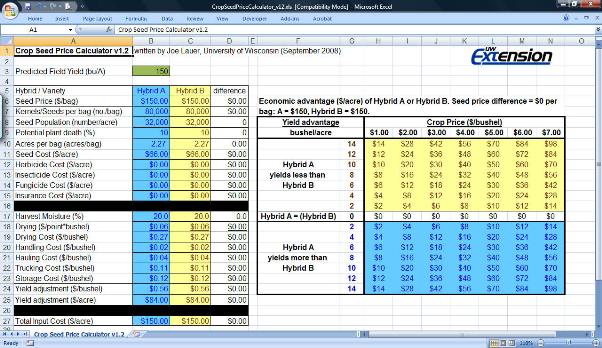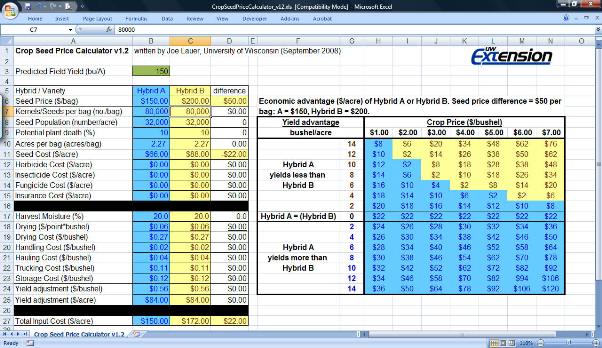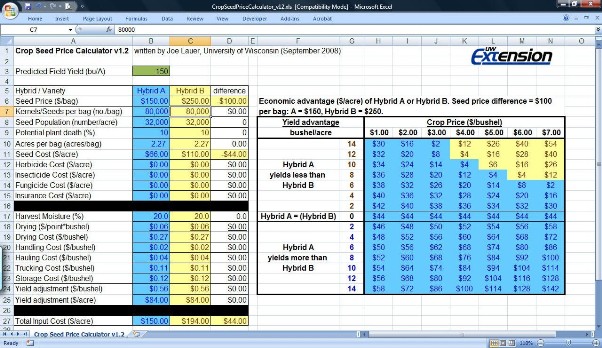
August 2008
Field Crops 28.31-60
Corn Hybrid Selection
Joe Lauer, Corn Agronomist
PDF Version
Growing Season Update
The 2008 production year has been one of the coolest on record. Growing degree unit
accumulation is tracking about 300 GDUs behind schedule. Temperature drives the
vegetative (V) developmental stages of the corn life cycle, but has less influence
during the reproductive (R) developmental stages (Table 1). The number of days from
silking (R1) to maturity (R6) ranges from 55 to 60 days. A farmer benchmark to gauge
the season is "To be dented by Labor Day." About 26-28 days remain for the crop
to mature.
|
Table 1. Relationship between corn kernel growth stage and development.
|
|
|
|
Growing Degree Units
(GDUs) to Maturity
|
Percent of
Maximum Yield
|
Moisture
Content (%)
|
|
Stage
|
Calendar Days
to Maturity
|
Southern
Wisconsin
|
Northern
Wisconsin
|
Grain
|
Whole
Plant
|
Grain
|
Whole
Plant
|
|
R1- Silk
|
55-60
|
1100-1200
|
950-1050
|
0
|
50-55
|
---
|
80-85
|
|
R2 - Blister
|
45-50
|
875-975
|
800-900
|
0-10
|
55-60
|
85-95
|
80-85
|
|
R3 - Milk
|
37-42
|
750-850
|
700-800
|
15-25
|
60-65
|
75-85
|
77-82
|
|
R4 - Dough
|
31-36
|
600-700
|
550-650
|
30-50
|
65-75
|
60-80
|
75-80
|
|
R5 - Dent
|
26-28
|
425-525
|
400-500
|
60-75
|
75-85
|
50-55
|
70-75
|
|
R5.5 - 50% Kernel milk
|
10-15
|
200-300
|
175-275
|
90-95
|
100
|
35-40
|
65-70
|
|
R6 - Maturity
|
0
|
0
|
0
|
100
|
95-100
|
25-35
|
55-65
|
Selecting Corn Hybrids for 2009
Past hybrid trials indicate that the average yield difference between the highest
and lowest yielding corn hybrid in a trial is 70 bu/A. Your challenge is to predict
performance the next growing season. Depending upon how you select hybrids, yield
gains up to 12 bu/A can be achieved over an "average" hybrid.
When choosing hybrids for the next growing season:
- Select hybrids using multi-location average data (Figure 1). Consider single location
results with extreme caution.
- Evaluate consistency over years and other trials. Be wary of hybrids that are not
top performers in all trials (Figure 1).
- Buy the traits you need (Tables 2, 3 and 4). Traits protect yield, they do not add
to yield. Can you grow corn the "old-fashioned" way?
- Rotation
- Weed control
- European Corn Borer
- Every hybrid must "stand on its own" for performance (Table
5). You don't know what
weather conditions (rainfall, temperature) will be like next year. Therefore, the
most reliable way to predict hybrid performance next year on your farm is to consider
past performance over a wide range of locations and climatic conditions.

Figure 1. Next year's performance of a hybrid using various selection strategies.
Simulated using UW Hybrid Trial Results 1973-1998 (L=Location, Z=Zone)

Table 2. Economic advantage ($/A) of Hybrid A or (Hybrid B). Seed price difference
= $0 bag: A = $150, (B) = $150.

Table 3. Economic advantage ($/A) of Hybrid A or (Hybrid B). Seed price difference
= $50 bag: A = $150, (B) = $200.

Table 4. Economic advantage ($/A) of Hybrid A or (Hybrid B). Seed price difference
= $100 bag: A = $150, (B) = $250.
|
Table 5. Relative performance among corn hybrid
"Families"
compared to the normal line grown in the same trial
|
|
Family
|
Specialty Trait
|
N
|
Grain
yield
|
Grain
moisture
|
Lodging
|
|
|
|
|
Bu/A
|
%
|
%
|
|
A12
|
DDBT418
|
6
|
1
|
1
|
2
|
|
A12
|
MMon810
|
6
|
20
|
1
|
-3
|
|
A12
|
MMonGA21
|
25
|
2
|
0
|
-1
|
|
B99
|
MMon810
|
3
|
15
|
3
|
-2
|
|
B99
|
MMon810+T25
|
3
|
-2
|
1
|
-1
|
|
C284
|
MMon810
|
24
|
17
|
1
|
-1
|
|
C284
|
MMon810+IT
|
6
|
-3
|
0
|
-1
|